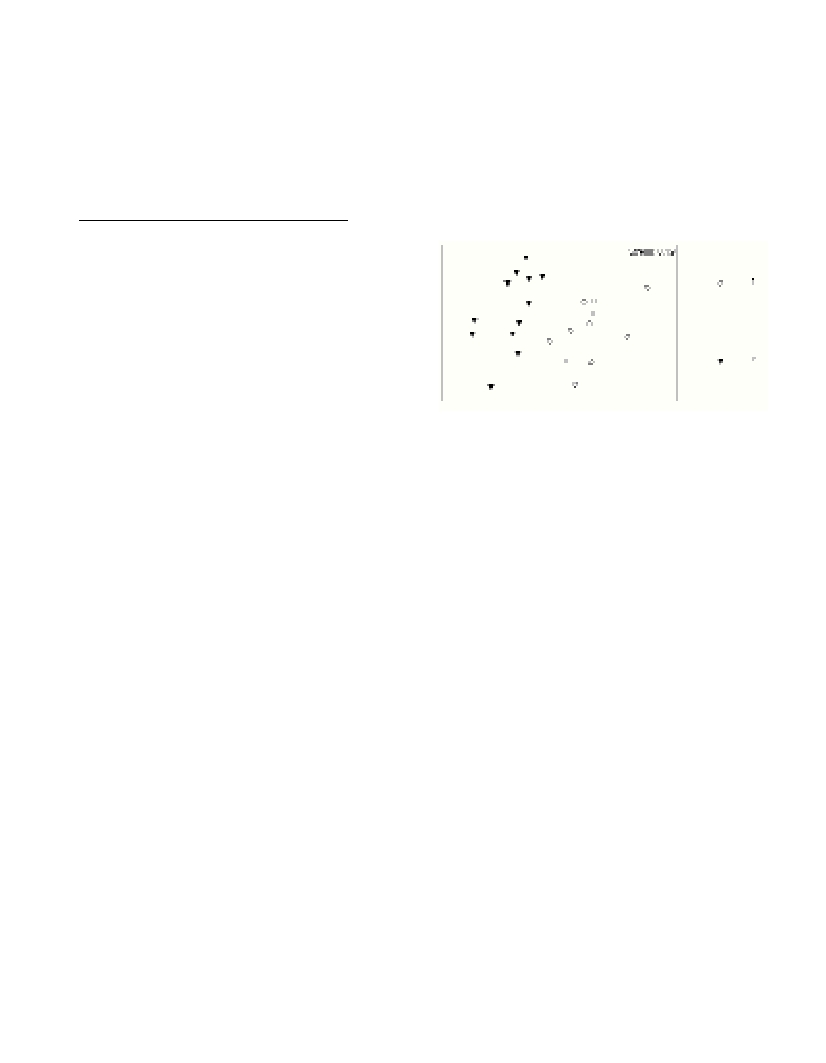PRELIMINARY OBSERVATIONS ON THE VARIATIONS IN THE MARINE MACROINFAUNA
IN FISHED AND UNFISHED AREAS
Sánchez P.* and Demestre M.
Instituto de Ciencias del Mar- CSIC, Barcelona, Spain - * pilar@icm.csic.es
Abstract
This paper reports the findings of a study conducted in the northwestern Mediterranean to evaluate the differences in the macroinfaunal
community in a fishing ground and an unfished zone. Univariate analyses of number of taxa indicated that the infaunal community differs
significantly in fishing ground and in the unfished zone. Multivariate analyses revealed that the communities in both fished and unfished
areas are also significantly different.
Key words: trawl, sea bed disturbance, macroinfauna
Rapp. Comm. int. Mer Médit., 37,2004
434
Introduction
The most important demersal mobile gear used in Mediterranean
fisheries is the bottom trawl. The towed gears are the most perturba-
tive form of anthropogenic disturbance to benthic habitats. Interesting
results have been achieved in 1 and 2. Recently, investigations has
began on the impact of the bottom trawl on the sea bed in the
Mediterranean (3-5).
This paper reports the preliminary findings of one study conducted
in the northwestern Mediterranean to evaluate the effects of bottom
trawl on fishing grounds. The aim of this paper is to provide informa-
tion on the possible differences between fished and unfished areas at
the macroinfauna level.
Material and methods
Two zones, one intensively fished at 50 m depth, and other unfished
at 60 m depth, were chosen in order to study the differences in their
macroinfaunal communities. The study area is located in southern
Catalonia (NW Mediterranean), where the fishing ?eet of Sant Carles
harbour operates. The sea bottom is characterised by a very wide shelf
(at some points over 65 km), with a predominance of muddy-sand and
mud bottoms, in?uenced by the Ebro river (6). A total of 23 0,1m
2
van
Veen grabs were sampled (11 in the fishing area, and 12 in the
unfished area). To establish the minimum area representing the bio-
cenose, cumulative curve was done. After sieving through a 1 mm
mesh size, the specimens of each haul were identified and counted.
Then, the same calculation was made for the amount of successive
cumulative grabs, after the addition of specimens per species was
made for every composition of samples. PRIMER statistical software
(7) was used to perform multivariate analysis on the community data.
A cluster analysis using the Bray-Curtis similarity index calculated on
square root transformed data and dendrograms formed using the
group average clustering method. The resultant similarity matrices
were used to perform non-metric multidimensional scaling (MDS)
(8). The non-metric MDS algorithm is an iterative procedure, con-
structing the MDS plot by successively refining the positions of the
points until they satisfy, as closely as possible, the dissimilarity rela-
tions between samples.
Results and discussion
The results of minimum area were that 0.54 m
2
is enough to repre-
sent this biocenose in both areas.
A total of 69 species or major taxa were collected. The effect of
fishing disturbance was already detectable, with significant differ-
ences in the number of species, 56 in the fished zone and 63 in the
unfished zone (t Student Nº taxa = -2.383, p<0.03). The abundance
percentage of taxa in the fished area: Polychaeta 39,3%; Sipunculida
1,8%; Echinodermata 3,6%; Crustacea 37,5%; and Mollusca 17,8%;
in the unfished area: Polychaeta 36,5%; Sipunculida 1,6%;
Echinodermata 3,2%; Crustacea 33,3%; and Mollusca 25,4%. The
MDS showing samples in figure 1. Two major groups can be
observed. Group f comprises the samples from fishing area and group
c samples from unfished area. The samples of unfished and fished
areas were clearly grouped in different assemblages. The two sam-
pling sites were clearly distinct (R= 0.617 p= 0.001; ANOSIM one-
way). The value of stress (0.19) indicates an excellent representation
of the relationship between the samples.
These are preliminary results of the differences between areas
intensely exploited by trawlers and areas not trawled due to wrecks or
other obstacles.
Acknowledgements. This paper is a part of the European Project
(VFP-QoL CONTRACT Q5RS2002-00787). The authors thank all
the participants in the cruise “Veda 1“ for their help. We also thank M.
R. Porras and Msr S. De Juan for their help in the laboratory.
References
1-Kaiser M.J. and Spencer, B.E. 1996. The effects of beam-trawl
disturbance on infaunal communities in different habitats. J. Anim. Ecol.,
65: 348-358.
2-Jennings, S. and Kaiser M.J. 1998. The effects of fishing on marine
ecosystems. Adv. Mar. Biol., 34: 351 p.
3-Demestre, M., Sanchez, P. and Kaiser, M.J. 2000. The behavioural
response of benthic scavengers to otter trawling disturbance in the
Mediterranean. Pp. 121-129. In: M.J. Kaiser, S.J. de Groot (eds.). The
effects of fishing on non-target species and habitats. Blackwell Science,
Oxford.
4-Sánchez, P., Demestre, M., Ramón, M. and Kaiser, M. 2000. The
impact of otter trawling on mud communities in the NW Mediterranean.
ICES J. Mar. Scienc., 57: 1352-1358.
5-De Biasi, A.M., Ardizzone, G.D., Biagi, F., De Ranieri, S., Demestre,
M., Kaiser, M., Nicoletti, L., Pacciardi, L., Sanchez, P., Sartor, P.,
Vannucci, A. 2002. Changes at very short time scale: an example from the
marine benthic communities. Assoc. Ital. Oceanol. Limnol., 15: 45-51.
6-Demestre, M., Sánchez, P, and Abello, P. 2000. Demersal fish
assemblages of the continental shelf and upper slope of the Catalan coast,
NW Mediterranean. J. Mar. Biol. Assoc. UK,80: 981-988.
7-Clarke, K.R. and Warwick, R.M. 1994. Change in marine
communities: an approach to statistical analysis and interpretation,
Natural Environment Research Council, Plymouth, UK. 114 p.
8-Kruskal, J.B. and Wish, M. 1978. Multidimensional scaling. Sage
Publications, Beverley Hills, California.
Fig. 1. MDS of samples (fished=f; unfished=c).

